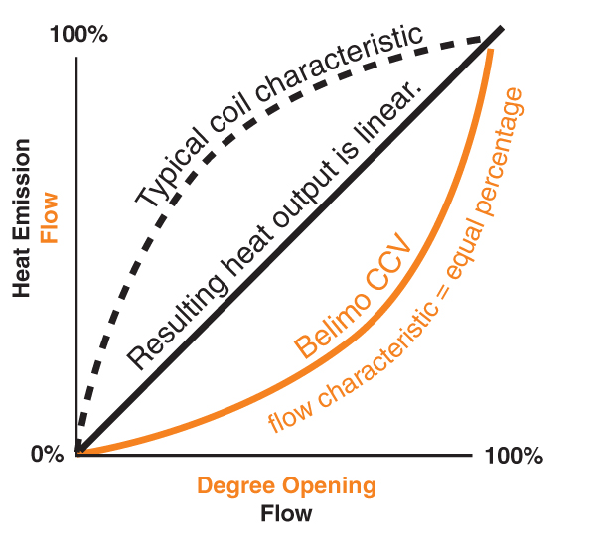Pressure Independent Characterized Valves (PICCV) versus conventional two-way control valves
A valve with an equal percentage characteristic has historically been used to counteract the nonlinear heat emission of the coils. The result is a linear heat emission versus the valve opening. This is a prerequisite for a stable control and a low proportional band of the control system. See Figure 1, 2 and 3. Unfortunately this situation is only true when the pressure is held constant as the valve goes from closed to open. This is a condition that exists in a laboratory condition only.


The flow rate of a conventional two-way valve depends upon both the degree of opening and the pressure. For example: a valve that is 50% open and supplies 5 GPM at 4 PSI, will at 36 PSI, supply 15.0 GPM at the same opening. When a conventional two-way control valve opens or closes, it causes pressure changes in the system. Often the pressure changes are quite large, and this causes a severe distortion of the valve’s ability to control. When all the valves are open the differential pressure is very low, but as they close the pressure increases more and more. Eventually the full pump pressure exists over the valves. The differential pressure across the valves increases quickly as the flow is reduced. This is due to the quadratic nature of the losses in the pipe, coil and other system components. See Figure 4, 5 and 6. These pressure changes cause a severe distortion of the valve characteristic and its ability to control in a stable manner.
The PICCVs are used as a replacement for conventional two-way control valves and will regulate the flow rate regardless of the differential pressure. In other words, it is a true flow controller. It consists of a differential pressure regulator in series with a control valve. The differential pressure is held constant over the control valve. This is what gives a specific flow for each degree of opening, regardless of the differential pressure over the whole PICCV valve. The pressure changes before and after the PICCV valve are absorbed by the pressure regulator, so the differential pressure across the control valve remains constant. See Figure 8. The flow rate of the PICCV valve depends only on how much the actuator has opened the valve. The actuator modulates the PICCV to a required flow rate, independent of the pressure. More stable flow means less work for the actuator, thus increasing actuator life. Learn more.


